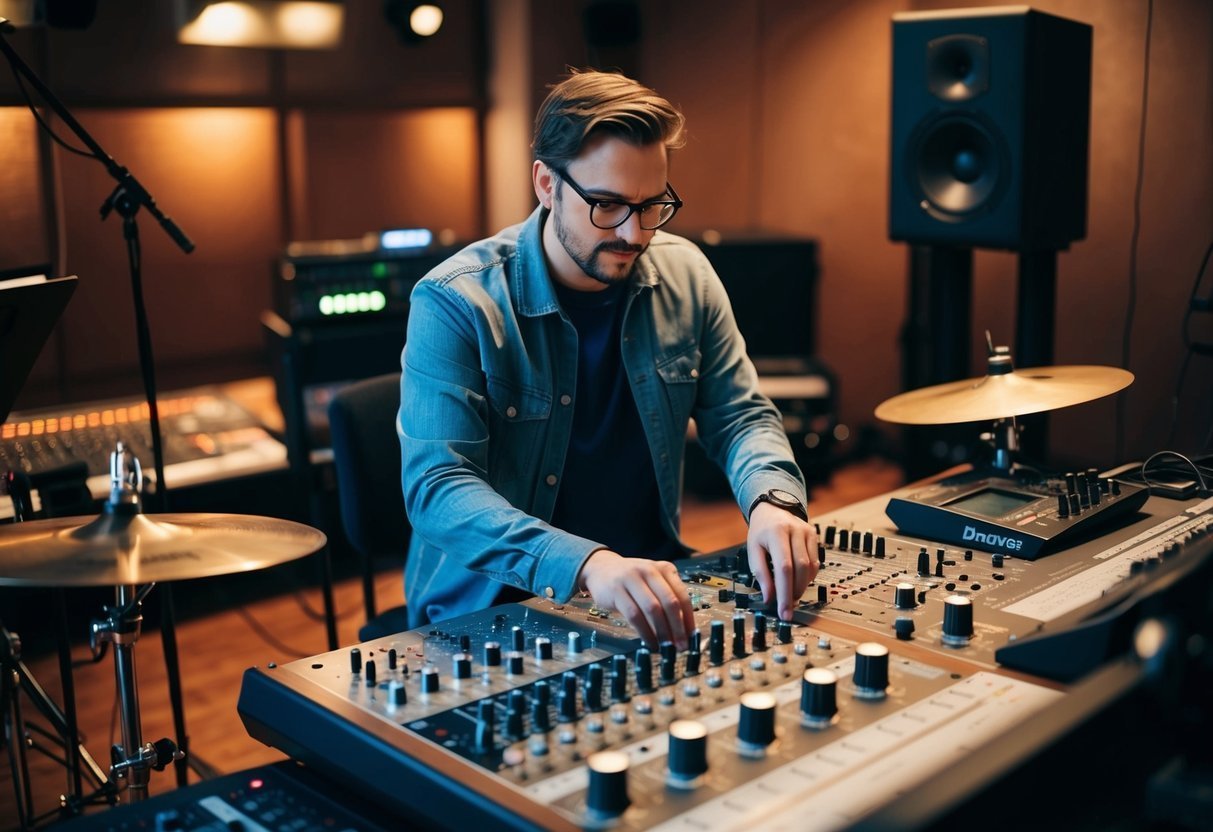If you’re stepping into the world of music production, you might find yourself asking: what exactly does a music producer do? Consider the producer as the behind-the-scenes magician, orchestrating the entire creative process.
This includes guiding artists, coordinating with sound engineers, and bringing musical ideas to life.
At the heart of it, a music producer is responsible for shaping the sound and direction of a track, album, or score. From selecting the perfect digital audio workstation (DAW) to ensuring the final mix is ready for release, producers wear many hats.
They might not always be in the spotlight, but their influence is felt in every beat and melody.
Whether you’re aiming to produce tracks or just want to understand the industry better, grasping the role of a producer is key.
This guide offers insights into the skills, tools, and techniques essential for success in music production, making it invaluable for newcomers and curious explorers alike.
The Basics of Music Production
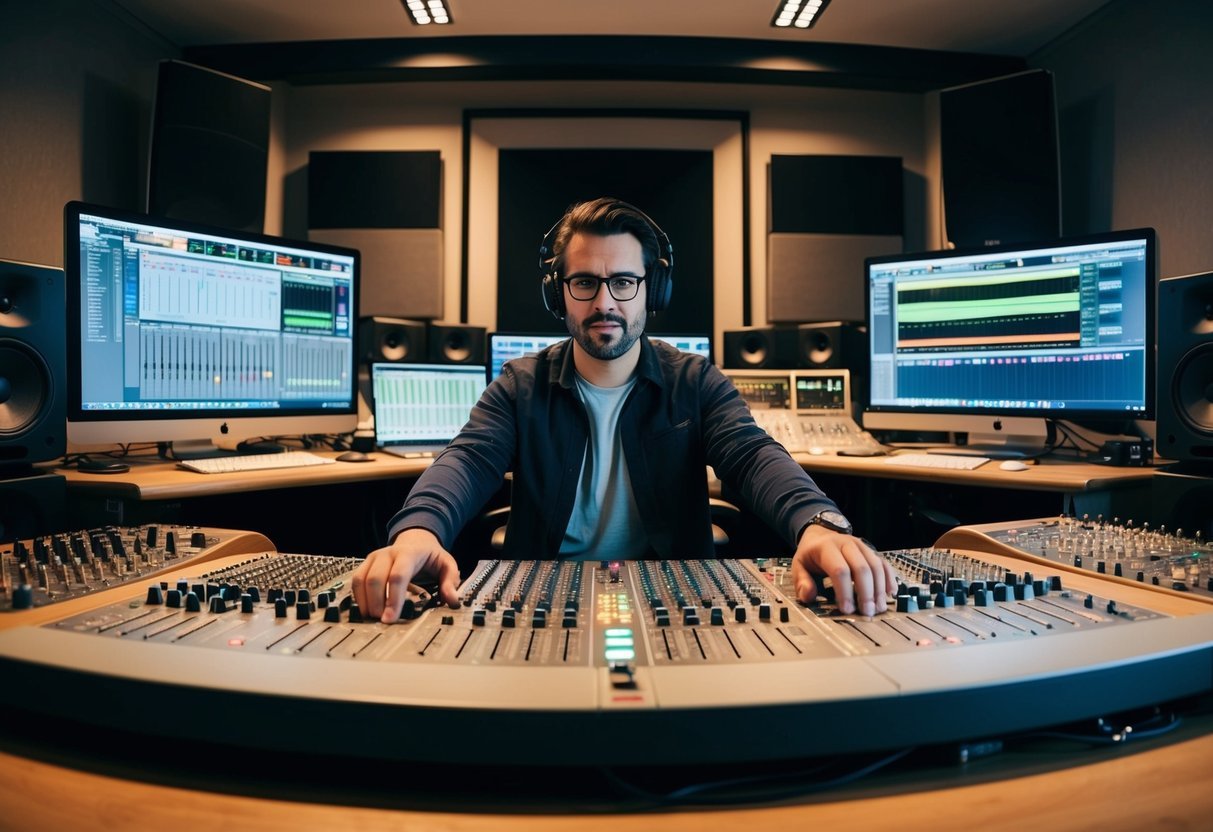
Getting into music production involves understanding the key concepts that drive the creative process.
You’ll learn what a music producer does and dive into the key stages of music production, which include mixing, mastering, and recording.
Defining the Role of a Music Producer
A music producer plays various roles in the music industry, often acting as a visionary for the project.
You’re essentially the director of the music production process.
This means you’re responsible for arranging the song’s structure, guiding the performance, and ensuring the track’s final sound aligns with the artist’s vision.
Your job may also encompass choosing the right instruments and effects that enhance the overall feel of the track.
You’ll often work with sound engineers, songwriters, and other artists.
The music producer’s creative influence can significantly shape a song and often determines its commercial success.
Coordination and communication are crucial as you may handle project logistics alongside creative tasks.
Understanding the Music Production Process
Music production includes several key stages.
You start with composition, crafting melodies, and writing lyrics.
Once that’s set, recording involves capturing the performance of instruments and vocals.
Next comes mixing, where you balance different audio elements.
You adjust volume, panning, and apply effects to create a cohesive sound.
Then there’s mastering, the final step, which polishes the mixed track to ensure clarity and quality across all playback systems.
Throughout these stages, your focus should be on creative decision-making, blending technical skills with artistic insight.
Setting Up Your Space
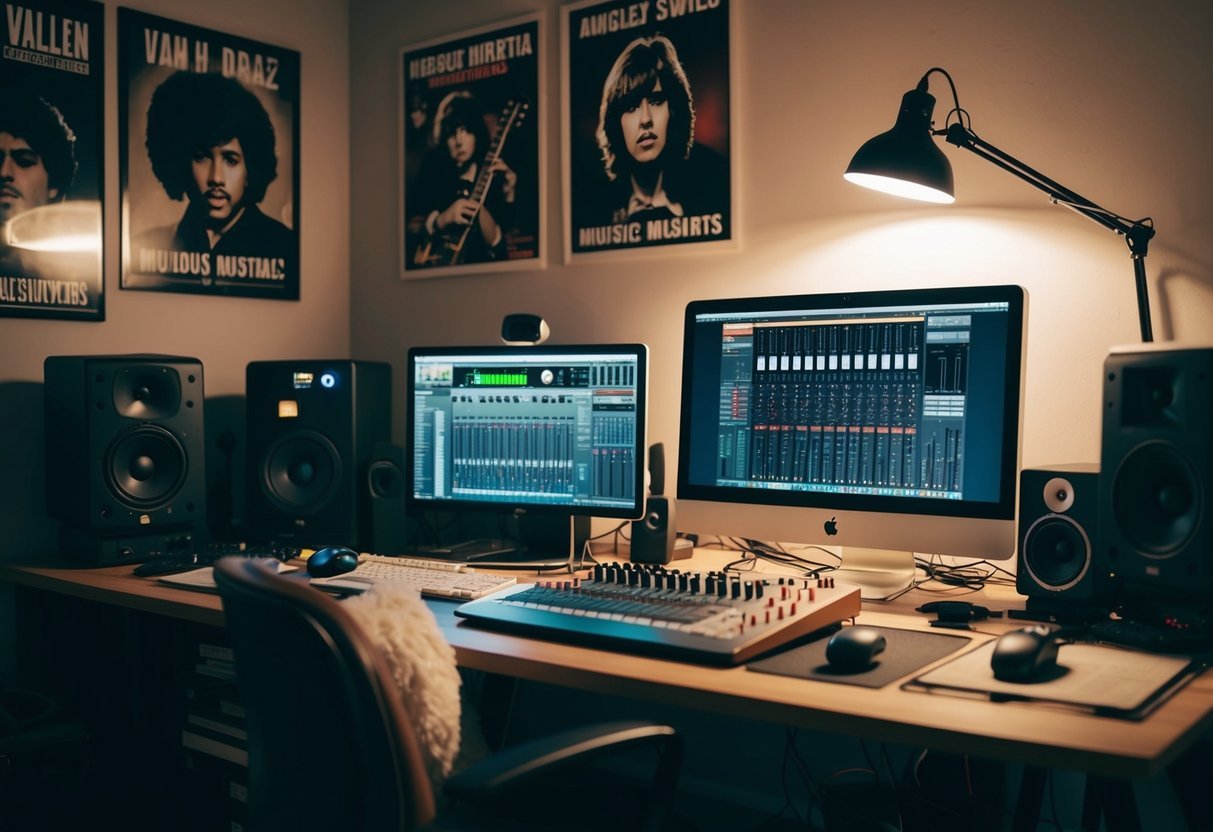
Creating the right environment is crucial for efficient music production.
From selecting the essential equipment to optimizing acoustics, each component plays a vital role in achieving a high-quality sound.
Choosing the Right Equipment
Choosing equipment for your studio involves balancing purpose and budget.
A high-performance computer is the heart of your setup, handling tasks like recording and editing.
Select an audio interface to connect microphones and instruments, ensuring high-quality sound input and output.
You’ll also need versatile microphones to capture voices and instruments effectively.
Investing in studio monitors is key for accurate sound representation, while a good set of headphones allows for detailed listening.
Don’t forget the basics like cables and stands, ensuring they’re sturdy and reliable.
A clear sense of what you’ll be recording and producing can guide equipment choices, making sure you’re prepared for different genres and styles.
Digital Audio Workstations and Software
Picking the right Digital Audio Workstation (DAW) is essential.
DAWs like Ableton Live, Logic Pro, and FL Studio each offer unique features, so consider your workflow and compatibility with your computer.
These platforms allow you to record, edit, and mix tracks efficiently.
Software plugins greatly enhance your DAW’s capabilities, offering effects, virtual instruments, and mastering tools.
Your choice will impact your production style, so take advantage of free trials to find what fits best for you.
Aim for software that offers a balance between powerful tools and user-friendly interfaces.
Remember to keep your software updated for the best performance and new features, ensuring your production process remains seamless and innovative.
Acoustics and Monitoring
The acoustics in your studio significantly affect sound quality.
Whether you’re in a home studio or professional studio, managing acoustics helps you achieve the best listening environment.
Soundproofing your space with acoustic panels minimizes unwanted noise and reflections.
Bass traps in corners address low-frequency issues, while diffusers spread sound evenly.
Position studio monitors at ear level and form an equilateral triangle with your listening position for optimal sound balance.
Calibration tools can also adjust your monitors to suit the room’s acoustics.
Regularly check audio in different settings using headphones and additional speakers.
This variety helps ensure your mix translates well across various playback systems.
Recording Techniques
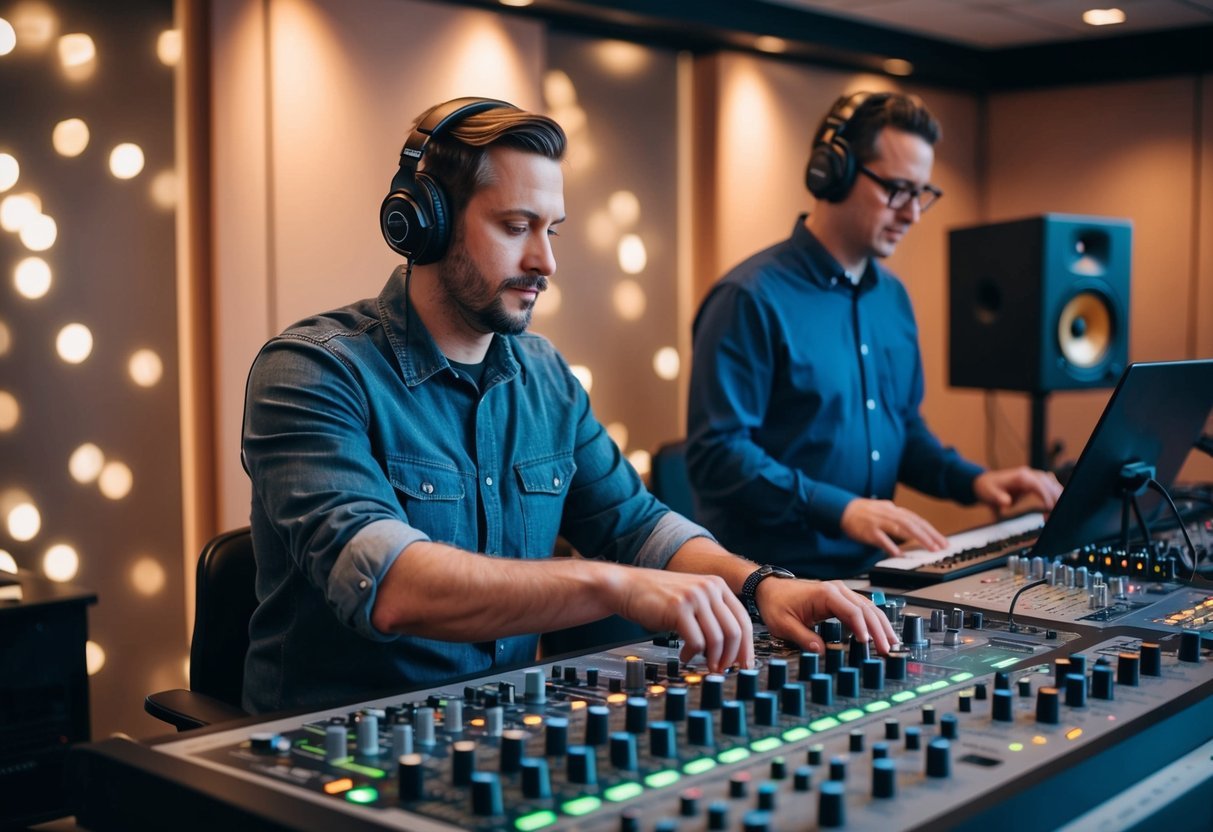
When it comes to recording, selecting the right equipment and understanding the process is crucial for capturing the best sound possible.
Microphone choice and placement can drastically change your results, while careful arrangement and tracking are key to producing a well-rounded track.
Microphone Types and Uses
Choosing the right microphone can make a world of difference. Dynamic microphones are sturdy and excel in handling loud sound sources like drums or amplified guitars.
They’re perfect for live settings too.
On the other hand, condenser microphones are sensitive and capture a broader range of frequencies, making them ideal for recording vocals and acoustic instruments.
You might also be interested in ribbon mics for their smooth, vintage sound, though they are more delicate.
Think about your recording space as well—condenser mics might pick up too much room noise if your studio isn’t treated properly.
Experiment with placement to find different sound textures.
Tracking Instruments and Vocals
The tracking phase involves capturing individual layers of your music.
Consider each instrument’s role in the overall sound.
Start by laying down a solid foundation with drum and bass tracks, which set the tempo and groove.
You can then add guitars, keys, or any other harmonic elements to build your track.
Recording vocals requires special attention; they often sit at the forefront of your mix.
A pop filter helps reduce plosive sounds, and adjusting your proximity to the microphone can vary the vocal tone.
Use these techniques to place emphasis where it fits your song’s vibe.
Consistent levels across tracks can simplify later mixing stages.
The Art of Arrangement
Arrangement involves crafting the structure and dynamics of your song.
Think of it as storytelling with your music.
You might start with a simple verse structure, build into a powerful chorus, and return to an introspective bridge.
The arrangement helps maintain listener interest and conveys emotional shifts.
Layer different elements like melodies, harmonies, and rhythm to create depth.
Don’t forget that silence can be as powerful as sound; it provides contrast and heightens dramatic points.
Testing different arrangements can reveal unexpected and unique combinations.
Composing Music
Composing music involves understanding how to create a musical structure and develop elements like melody, harmony, and rhythm.
You must think about songwriting, balance different sections, and use rhythm to engage the listener.
Songwriting and Structure
In songwriting, you want to craft a narrative or a journey.
This usually involves a clear structure, typically with sections like verse, chorus, and bridge.
The verse sets up the story or theme, leading to the chorus where the main idea or emotion is emphasized.
A bridge provides contrast and keeps the listener interested.
Having a grasp on different song forms, such as verse-chorus, ABAB, or AABA, helps you maintain variety and coherence in your compositions.
Melody and Harmony
Melody is what sticks in people’s heads.
Creating compelling melodies means combining notes in appealing and memorable ways.
Consider the melody as the focal point and explore chord progressions to support it.
This is where harmony enriches your melodies, adding depth and texture.
Think about how the chords change and develop to keep the listener engaged.
Playing with tension and release through different harmonic choices can lead to emotionally resonant music.
Rhythm and Timing
Rhythm gives music its flow and drive.
It’s essential to understand how rhythms fit together and set the overall timing of a piece.
Experiment with different rhythmic patterns to find what best suits the mood and style you are aiming for. Syncopation and varying time signatures can create interest and movement.
Consider using tools like metronomes or rhythm exercises to enhance your timing skills and create music that resonates with a natural pulse.
Creative Approaches to Production
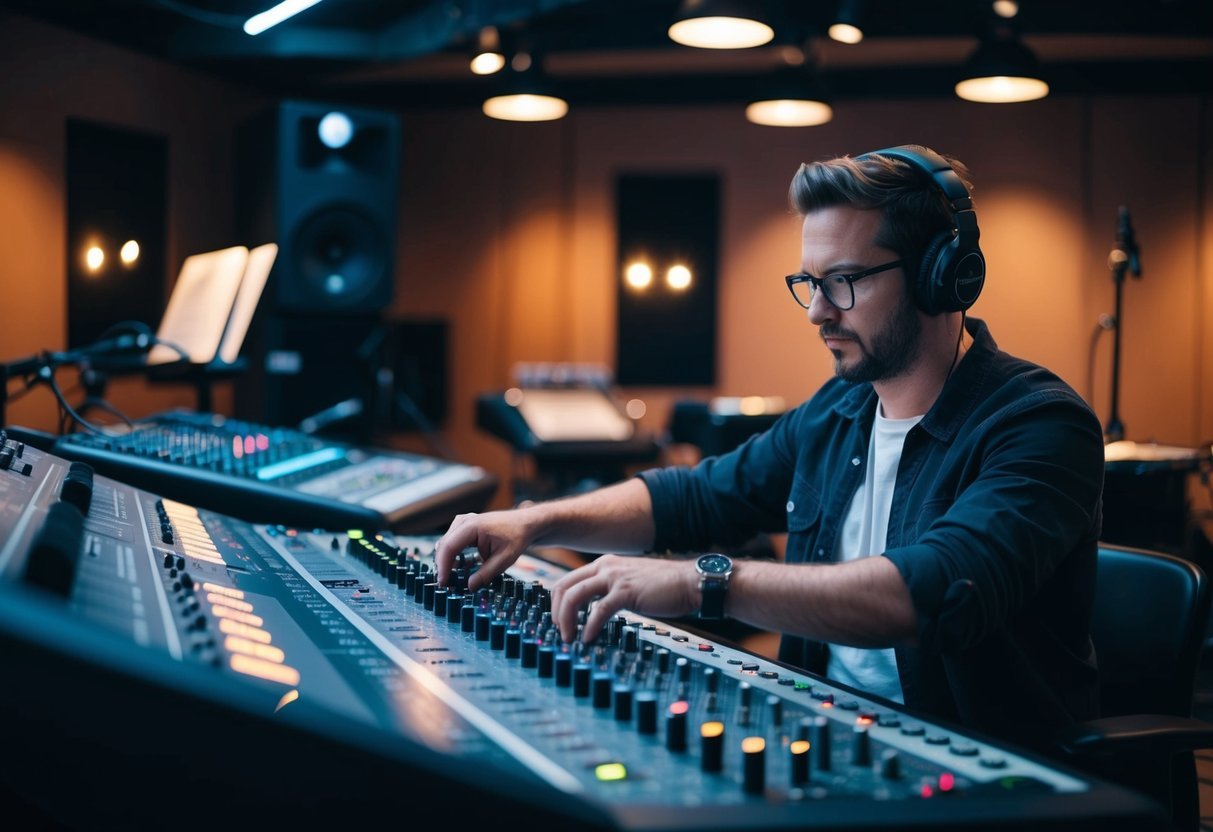
Music production is all about pushing boundaries and discovering new sounds.
As a music producer, you play a crucial role in shaping the creative expression of an artist.
By exploring different genres, embracing sound design, and crafting unique production styles, you can unlock limitless possibilities.
Exploring Genres and Styles
The world of music is rich with genres and styles waiting to be explored.
By stepping into different musical landscapes, you can find inspiration and fresh ideas for your production work. Experimenting with genres like electronic, pop, hip hop, or indie rock allows you to uncover distinctive soundscapes and techniques.
Collaborating with artists from various backgrounds helps broaden your creative palette.
By understanding the nuances of each genre, you can tailor your approach to match the artist’s sound.
Embrace cultural influences from around the world to create a fusion of styles that captures listeners’ attention.
Try combining elements from different genres to produce a unique sonic identity that stands out.
Sound Design and Synthesis
Sound design is where your creativity takes center stage.
As a producer, mastering synthesis and sound manipulation is key.
With tools like synthesizers, samplers, and digital audio workstations (DAWs), you can shape sounds that are entirely original.
Dive into the process of synthesizing sounds to add depth and dimension to your music, experimenting with oscillators, filters, and modulation techniques.
Consider layering sounds to create rich textures, adding effects like reverb, delay, or distortion to bring your productions to life.
Collaborate with sound designers or practice experimenting with different plugins and hardware to elevate your tracks.
Crafting the Artist’s Sound
As a producer, your goal is to bring out the best in the artist by crafting a sound that resonates with their vision.
Get involved in the artist’s creative process, offering guidance on everything from song structure to vocal delivery.
By closely collaborating with the artist, you create an environment conducive to artistic exploration.
Encourage them to express their authentic self through music, while you support them with your technical expertise.
Tailor production elements to enhance the artist’s voice and message, whether it’s intricate vocal harmonies, unique instrument choices, or standout arrangements that define their style.
The Digital Toolbox
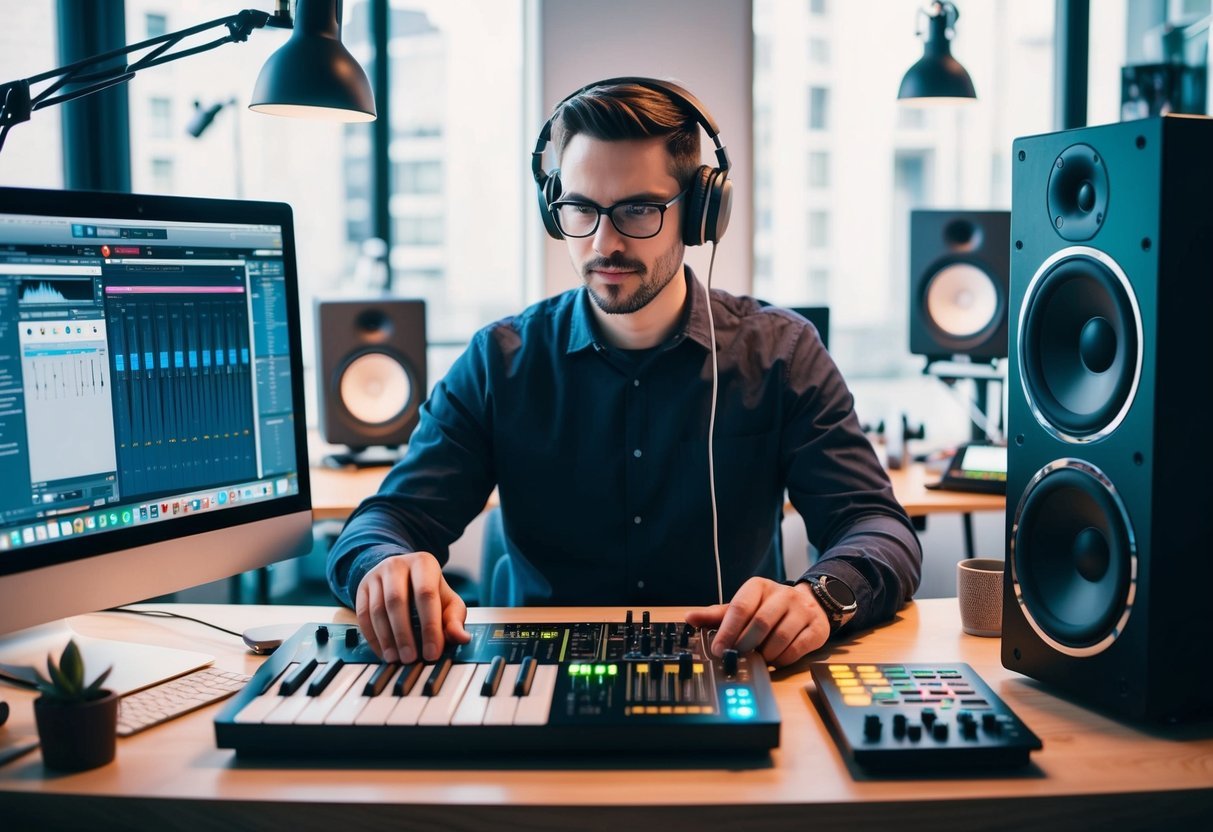
Modern music production depends on a variety of digital tools that empower producers to craft and refine their sound.
These tools include MIDI technology for creating music, software plugins that enhance sound, and automation features that streamline the production process.
MIDI and Virtual Instruments
MIDI is like the bridge between your creativity and your computer.
It allows you to play virtual instruments on your DAW using a MIDI keyboard or controller.
The flexibility with MIDI means you can adjust notes, change instruments, or tweak the tempo after recording without redoing the performance.
Virtual instruments come in many forms, mirroring real-world instruments or offering entirely new sounds.
They range from realistic pianos and strings to electronic synths and drums.
With MIDI, you can easily control various parameters, giving you the ability to replicate an orchestra or create a thrilling beat.
Software Plugins and Effects
Plugins are essential to elevate your music’s sound.
They function like apps for your DAW, providing effects, instruments, and sound manipulation tools.
From reverbs that add space to your mix to EQs and compressors that shape your sound, plugins are your go-to tools for refining every detail.
There are thousands of plugins available, both free and paid. Choosing the right ones can be daunting but focus on those that suit your style.
Try experimenting with different effects to discover how they transform your tracks.
Remember, subtlety is often key in music production; sometimes a small tweak leads to big results.
Automation in Your DAW
Automation lets you add dynamic changes to your tracks over time.
This feature can control virtually any parameter, like volume, panning, or specific effects.
With automation, you aren’t just creating a static track; you’re crafting a journey for the listener.
Using automation, your chorus can gradually increase in intensity, or an echo effect can fade in and out seamlessly.
It makes your compositions more engaging and professional, allowing for detailed modifications without constant manual adjustment.
In essence, automation helps you fine-tune your project to perfect the flow and emotion.
Editing and Post-Production
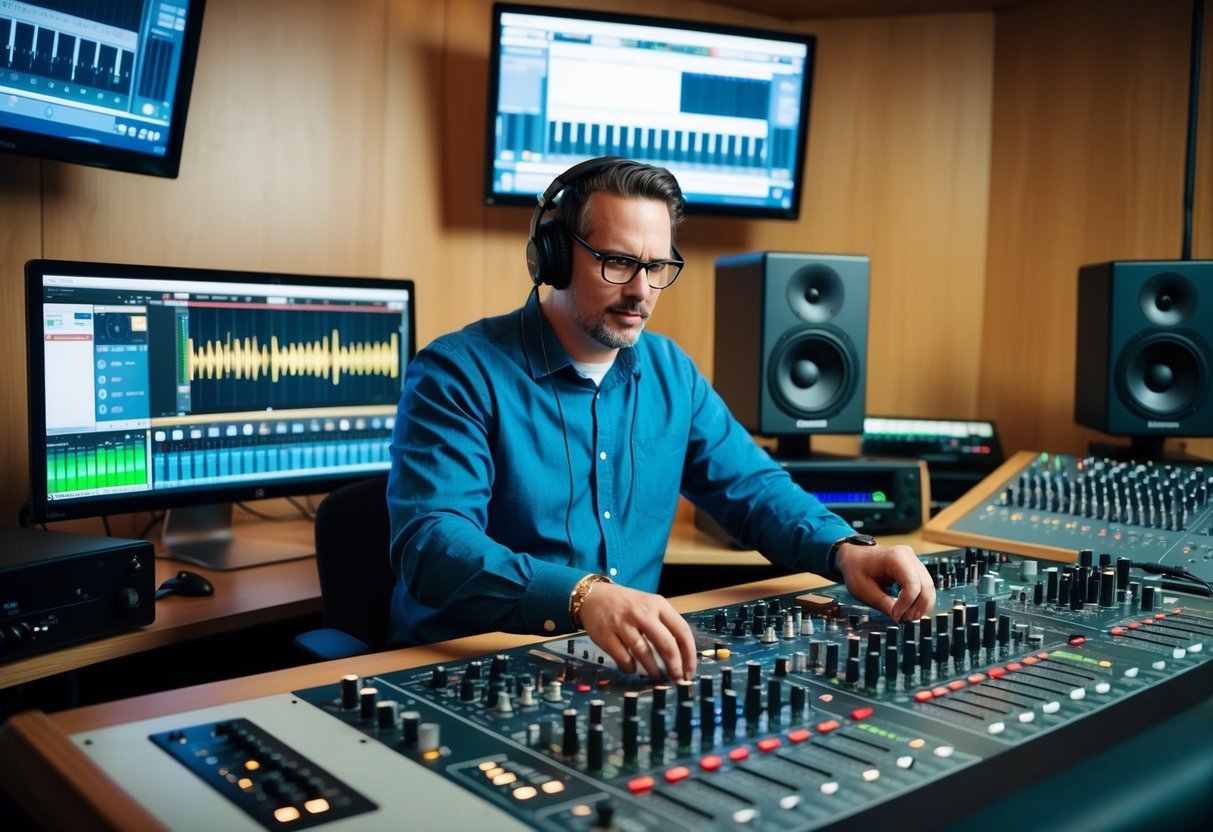
As you journey through the editing and post-production phase, it’s crucial to hone skills in audio editing, EQ, and compression.
Each component plays a significant role in creating polished and professional music tracks.
Audio Editing Basics
Imagine you’re cutting a piece of paper—a bit here, a bit there, until everything fits perfectly.
That’s kind of what audio editing is like.
It’s about taking recorded sound and fine-tuning it.
You might find yourself trimming waves, moving segments, or even rearranging entire sections of a track. Editing sharpens your audio, removing unnecessary parts and enhancing overall quality.
Get comfy with your digital audio workstation (DAW).
Learn to cut, paste, and splice audio clips.
Experiment with features like crossfades for smooth transitions between sounds.
Remember, perfection in your editing gives your music clarity and appeal.
The Importance of EQ
EQ (Equalization) is like the seasoning in a good dish—it flavors the sound.
You’ll use it to balance frequencies, ensuring that no sound is too muddy or too sharp.
Picture your track broken into three parts: lows, mids, and highs. EQ allows you to boost or reduce these frequencies to shape your sound.
It helps you highlight the bass in a dance track or the vocals in a pop song.
You’ll start by identifying frequency clashes, using EQ to carve out space in busy mixes.
Adjusting can help vocals to cut through and reduce muddiness.
Embrace EQ to give your track a cleaner, more professional finish.
Using Compression Effectively
Compression is your secret weapon for making sounds pop! It controls the dynamic range of your audio, evening out loud and soft parts.
Imagine a rollercoaster ride—without compression, your track’s volume will jump wildly up and down.
Compression smooths these peaks and valleys.
You’ll apply it to maintain consistent levels throughout a song and bring quieter sounds upward.
Set proper threshold and ratio settings in your compressor to make sure your track breathes naturally.
Too much compression can squash the life out of your music, making it sound flat.
Try different settings to achieve a balanced, lively sound.
Mixing for Impact
Mixing significantly influences the final sound quality of a track.
It involves balancing audio tracks, adjusting dynamics, and using effects like reverb to enhance the listening experience.
Balancing Tracks and Dynamics
Balancing tracks is crucial for a polished mix.
It means setting the right volume for each audio track, so no part overshadows another.
You’ll need to pay attention to dynamics, ensuring parts like the vocals are clear and prominent.
Using automation can help manage changes throughout the track.
This way, you create a dynamic mix, keeping the listener engaged.
A mixing engineer often uses equalization (EQ) to carve out space for each instrument, which helps maintain balance and prevents muddiness.
The Use of Reverb and Spatial Effects
Reverb can add depth to your mix by simulating space, whether it’s a small room or a large hall.
It gives instruments a sense of place, making a track feel more immersive.
Apply reverb to create space for each element, but be cautious not to overdo it, as too much can muddy the mix.
Spatial effects like panning distribute sounds across the stereo field, enhancing the width of your mix.
This separation is vital for impact, allowing each sound to sit well within the mix, adding to the realism and overall engagement of the track.
Achieving Clarity in the Mix
Clarity is achieved by careful EQing and removing unnecessary frequencies.
Using a high-pass filter allows you to cut low frequencies from instruments that don’t need them.
This helps clean up the mix and makes room for bass-heavy elements like kick drums and basslines.
Compression is another tool that helps in achieving clarity.
It controls the volume of tracks, making sure softer sounds aren’t lost while louder parts aren’t overwhelming.
Finally, listening to your mix on various speakers helps ensure clarity across different playback systems, ensuring a consistent listener experience.
Mastering the Final Product
Mastering is the process that transforms a mixed track into a polished final product.
It focuses on loudness, clarity, and overall balance, ensuring tracks are ready for various distribution platforms.
Understanding these key areas will help you maximize your music’s potential.
The Objective of Mastering
Mastering aims to create a cohesive, high-quality audio experience across all tracks on an album.
This involves ensuring the loudness is consistent and that each track maintains its quality on different playback systems.
Another goal is to prepare a track for distribution, adapting it for various formats like streaming or physical media.
Mastering is essential for forming a unified sound that elevates the listening experience, making it more enjoyable for everyone.
Enhancing Loudness and Polish
Enhancing loudness is critical in mastering, making tracks sound fuller and more vibrant without distorting the sound.
Tools like compressors and limiters help you adjust the dynamic range, ensuring the audio remains crisp and clear.
Polishing involves EQ adjustments that refine the sound by balancing frequencies.
This adds brightness or warmth as needed.
The aim is to achieve a professional sheen that complements the artist’s intention. Loudness and polish are crucial in capturing the listener’s attention and making the music sound complete.
Preparing for Distribution
Preparing your track for distribution involves formatting and finalizing the audio file.
This ensures compatibility with various platforms like Spotify, Apple Music, or physical formats such as CDs or vinyl.
Ensuring proper metadata tagging and track sequencing is also part of this stage.
Metadata helps platforms display correct information, while sequencing guarantees your album tells the intended story.
Proper preparation allows your music to shine wherever it’s played, maintaining quality across all channels.
The Business of Producing
The business side of music production involves understanding the complexities of the music industry, fostering professional relationships, and strategically building your career.
Mastering these elements is essential for any aspiring music producer looking to succeed.
Understanding the Music Industry
To thrive as a music producer, it’s crucial to grasp how the music industry operates.
It’s a landscape filled with labels, streaming services, and legal considerations. Familiarize yourself with different music rights such as mechanical, performance, and sync rights.
Knowledge of these can help you protect your work and ensure fair compensation.
Collaborate with professionals like composers and mixing engineers to enhance your projects and learn from their expertise.
Consider joining industry organizations that offer valuable resources and networking opportunities.
Networking and Collaboration
Networking is the key to establishing a successful career in music production.
Building connections with artists, composers, and audio engineers can open doors to new opportunities. Attend industry events such as conferences and workshops to meet potential collaborators and gain fresh insights.
Use online platforms to network with professionals worldwide.
Connecting with others can lead to collaborations that improve your skills and expand your portfolio.
Don’t hesitate to reach out to people whose work you admire; a simple message can lead to future projects.
Building a Career as a Producer
As a producer, crafting a career involves both creative and strategic planning.
Start by identifying your niche or the genre you are most passionate about.
Develop a branding strategy that highlights your unique sound and style.
Build a strong online presence through social media and professional networks like LinkedIn.
Engage with your audience regularly and showcase your work through different platforms.
Consider creating a portfolio that includes completed projects and testimonials from artists you’ve worked with to attract potential clients and collaborators.
Frequently Asked Questions
Explore the steps to start as a newbie music producer, the potential earnings at the beginning, and what skills will help you succeed.
You’ll also find out if formal education is necessary and what daily tasks music producers handle.
What’s the first step to becoming a music producer as a newbie?
Start by learning the basics of music theory and production.
Get hands-on experience with digital audio workstation (DAW) software like Ableton Live or FL Studio.
Experimenting with creating your own tracks is key to building your skills.
Can you make decent money when you’re just starting out in music production?
In the beginning, earnings can be modest.
You might start with gigs like working with local artists or producing for online platforms.
Building a solid reputation can lead to more lucrative opportunities.
What are the basic skills needed to kick off a career as a music producer?
Understanding music theory, proficiency with DAW software, and strong communication skills are crucial.
You’ll also benefit from a good ear for music and creativity in sound design and arrangement.
Is it possible to become a music producer without going to school for it?
Yes, many successful music producers are self-taught.
Online courses, tutorials, and practice can help you gain the necessary skills without formal education.
Being proactive and curious is essential.
What do music producers do all day, anyway?
Your day might include creating and arranging tracks, collaborating with artists, and mixing and mastering songs.
You’ll also spend time handling scheduling, budgets, and possibly marketing, depending on your role.
Can I still make a go at music production if I have zero experience?
Definitely.
Everyone starts somewhere, and it’s all about diving in and learning as you go.
Start small, seek feedback, and continually refine your craft to grow in this field.

